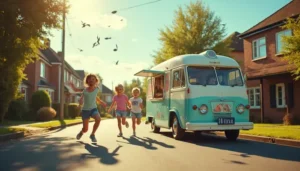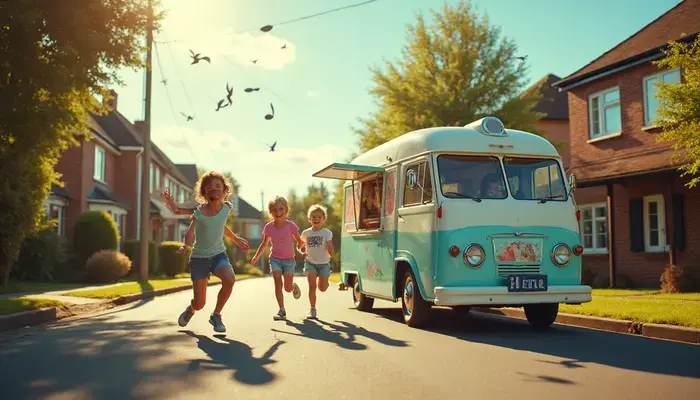Ice Cream Van Music: History, Rules, and Popular
The familiar chimes of Ice Cream Van Music: bring back memories of childhood summers for most of us. These beloved melodies follow strict regulations in the UK. The rules allow chimes to play only for 12 seconds every two minutes, and they must stop after 7 PM. Sound levels can’t go above 80 decibels, which creates a perfect balance between catching attention and keeping neighborhoods peaceful. Source
The UK’s ice cream van landscape includes roughly 5,000 vehicles that fill the air with classic tunes like “Greensleeves” or “O Sole Mio.” A single company in Staffordshire produces most of these musical systems. The musical tradition has spread beyond British borders, and Whitby Morrison, Britain’s largest manufacturer, has shipped its musical ice cream vans to more than 60 countries. This piece explores the captivating story behind these nostalgic melodies – from their roots in history to modern-day rules and the popular tunes that send us running for a cone on those hot summer days. See ice cream vans for sale
The origins of ice cream van music
The sweet melody of an ice cream van brings kids running to the streets in neighborhoods worldwide. The story behind these familiar tunes goes back much further than most people think. Hire an Ice Cream Van
Early use of bells and mechanical chimes
Ice cream vans have a fascinating past. Street vendors sold penny-licks from static vans in the 1870s. The first motorized ice cream vans hit the roads in the 1910s. Back then, vendors had simple ways to let people know they were coming, before musical tunes became common.
Harry Burt, an Ohio candy maker, became the first person to add sound to his ice cream trucks. He covered his truck with bells to tell customers he was in the area. This idea worked so well that he added bell systems to twelve more trucks in his fleet. See Ice Cream Van Tracker
Early sellers tried different ways to grab attention. Some used bells while others blew bugles. Local councils quickly banned the bugles because they were too noisy. In America, Good Humor trucks stood out by using traditional sleigh bells from actual sleds. See all posts Ice Cream Vans
Not everyone loved these sounds. A vendor got fined in 1950 for playing his “musical hooter” too loud at night. Many drivers faced fines in 1950-51 for using their van horns to attract customers.
A game-changing moment came in April 1952. Rose Monfredi got tired of paying fines for horn-blowing and fitted a proper music box to her van. She drove through Sheffield playing “Auld Lang Syne.” The music stopped automatically when the van stopped – quite innovative for those days. See how to start an ice cream van buisiness
The first chimes worked just like traditional music boxes with magnetic pickups and amplifiers. The year 1958 brought big changes as transistors transformed van chimes. New amplifiers could now connect straight to the van’s battery.
Why music became essential for ice cream vans
Cars became more common after World War II and suburbs grew bigger. Ice cream parlors struggled to reach scattered customers so Ice Cream Van Music:. Music boxes in trucks solved this problem perfectly.
Musical calls proved their worth quickly. One seller said kids would get so sad when his chime-less van showed up that he had to install one. “The chimes are great—they tell everyone a nice treat is coming,” he said.
Ice cream van jingles work because they’re unique and nostalgic. Studies show music helps people remember things better. That’s why jingles play such a big role in marketing everywhere. Chicken Tonight’s research found it takes about 17 minutes to get a tune out of your head—experts call this an “earworm”.
Ice cream truck jingles follow a special recipe. Expert Dan Neely says they need:
- Songs kids know from kindergarten or older tunes
- Happy melodies that repeat
- Tunes that work as short jingles
- Melodies people recognize in seconds
British ice cream vans used Grampian Horn speakers pointed down at the road to spread the sound. Better technology came along over the years, but people still love that classic “tinny” ice cream van sound.
The 1980s saw electronic chimes take over from old clockwork music boxes. They sounded better and broke down less often. A big leap forward came in 1986 with the Harmony 16. This innovative machine gave vendors three-note harmonies and more than 150 tunes to choose from.
How ice cream van music is regulated in the UK
The cheerful tunes of UK ice cream vans bring back childhood memories, but there’s a detailed set of rules that keeps these nostalgic sounds from becoming a neighborhood nuisance. These rules help balance the tradition with local peace and quiet.
DEFRA Code of Practice explained
The Department for Environment, Food & Rural Affairs (DEFRA) created the “Code of Practice on Noise from Ice-Cream Van Chimes in England” in 2013. This detailed document spells out what sounds ice cream vans can legally make. Vendors and local authorities use this code as their guide for handling noise complaints.
The code focuses on loudspeakers attached to ice cream vans and similar vehicles. Vendors can keep these guidelines displayed inside their vehicles. This isn’t just a suggestion – it carries legal weight. Vendors can use their compliance as a defense in court if someone takes legal action against them.
Time and volume restrictions Ice Cream Van Music:
The rules are strict about when ice cream van music can play:
- Chimes work only between 12 noon and 7:00 pm
- Music plays for just 12 seconds at a time
- A 2-minute gap must exist between chimes
- Streets hear chimes once every 2 hours
The rules also control volume levels carefully. Chimes must stay under 80 decibels from any direction – about as loud as busy traffic or a dog’s bark, but quieter than your hairdryer. The current 12-second rule actually gives vendors more flexibility. Before 2013, they could only play music for 4 seconds.
Most modern ice cream vans now come with smart loudspeakers. These automatically stop after the allowed time to help vendors follow the rules.
Sensitive areas where music is banned
The UK ice cream van music law creates clear zones where chimes can’t play at all, especially near:
- Hospitals or similar places (within 50 meters)
- Schools during class hours (within 50 meters)
- Places of worship on Sundays or other worship days (within 50 meters)
The rules also say vendors can’t play chimes if another ice cream van sits visible on the same street. This stops multiple tunes from creating noise chaos in neighborhoods. The law wants to protect sensitive groups while keeping this beloved tradition alive.
Penalties for breaking the rules
Breaking these rules can land vendors in serious trouble. Section 62 of the 1974 Control of Pollution Act lets authorities issue noise warnings or take vendors to court.
Some vendors learned this lesson the hard way. A street completely banned one ice cream van in 2021 after its tune broke both the 12-second limit and volume rules. Local authorities investigated and enforced the ban.
Vendors who stick to DEFRA’s Code of Practice have a strong defense if someone takes them to court. This shows why following the code matters – it protects vendors who play by the rules.
Local councils handle complaints through their environmental health teams. People can report problems using noise pollution forms. This kicks off investigations that might lead to action against vendors who break the rules.
Different styles of ice cream van music around the world
The melodies from ice cream vans create unique soundscapes in different parts of the world. These musical signatures reflect each region’s cultural heritage and priorities. The simple marketing tool has become a cherished tradition with its own local character.
English ice cream van music traditions
“Greensleeves,” a traditional English folk tune centuries old, has become the signature sound of British ice cream vans. This melody connects generations of Britons who recognize it instantly. The Mr. Whippy brand started this tradition. Its founder Dominic Facchino, inspired by Henry VIII’s supposed connection to Greensleeves, made it his fleet’s signature tune in Birmingham back in 1958.
British vans play other popular tunes like “O Sole Mio,” “Match of the Day,” and “The Harry Lime Theme” from the 1949 film The Third Man. Some vans in 1959 played classical pieces such as “The Blue Danube” and Verdi’s “Anvil Chorus”.
MicroMiniatures in Staffordshire now produces chimes for most of Britain’s 5,000 ice cream vans. Their catalog includes everything from “Jerusalem” to “Nessun Dorma” and even “The Stripper”.
Popular tunes in the US and Canada
American ice cream trucks use a wider range of music compared to the UK’s Greensleeves tradition. The Mister Softee jingle stands out as a truly American creation from 1960. Arthur Pryor, once a trombone soloist with the Sousa band, composed this melody. It later got lyrics for TV commercials before making its way to the trucks.
American ice cream music often features “Turkey in the Straw,” “Pop Goes the Weasel,” and Scott Joplin’s “The Entertainer.” The last one became popular after the 1973 film The Sting. Canadian trucks sometimes take a different path, with some areas playing “La Cucaracha”.
New York City saw an interesting turn of events when Mayor Bloomberg banned ice cream truck jingles in 2002 during a noise crackdown. Public pushback made him reverse course, though trucks still can’t play music while parked.
Scandinavian ice cream van melodies Ice Cream Van Music:
Norwegian ice cream vans play “Norge rundt,” a unique tune that represents their nationwide presence. Sweden’s Hemglass brand, launched in 1968, created one of Scandinavia’s most recognized – and debated – ice cream melodies.
The Hemglass jingle comes with its share of controversy. Composer Robert Sund says he pitched several tunes to the company in the 1980s, only to hear a modified version being used without credit. He told Göteborgs-Posten newspaper: “I disclaim all responsibility for the melody. I did not write this sound”.
The Swedish tune has split public opinion. Some citizens have taken legal action against what they call “incessant noise pollution.” So far, courts have supported the ice cream company’s position.
The technology behind the music
The rise of ice cream van music technology tells an amazing story of mechanical ingenuity and technological breakthroughs. Those nostalgic tunes we all know have a century-long story of development that created summer’s most recognizable soundtracks.
From music boxes to digital chime systems
The first dedicated ice cream van music systems appeared around 1929. A California ice cream vendor attached a music box to his truck’s roof and connected it to an amplifier. These early systems needed vendors to crank music boxes by hand – a tough task while driving that often made tunes stop suddenly mid-route. Nichols Electronics changed everything in the 1950s by creating transistorized music boxes powered by the vehicle’s battery.
The Nelson Company started manufacturing chime boxes after World War II, but they struggled with power efficiency. A game-changing moment arrived in 1957 when Nichols Electronics improved the electronic design and later launched digital versions in 1985. One driver’s experience stands out – he listened to the same 40-second song about 13,500 times.
How ice cream van music boxes work
Modern ice cream van music boxes have three most important parts: the chime with music and amplifier, the speaker (drive-head), and the trumpet. The chime box contains musical programming and amplifier, using the vehicle’s 12-volt system to power the speaker. The trumpet sits under the speaker and projects sound as far as possible.
Today’s systems pack impressive features. Whitby Morrison’s Carillon chime system comes with three standard tunes but gives access to almost 100 classic and modern ice cream chimes. The Nichols Electronics’ Omni 2 ($178.69) includes 32 preloaded public domain songs.
Custom chimes and music downloads
Ice cream vendors looking to personalize their music have several options. Nichols Electronics’ Mark IV single-song music box lets vendors program up to 59 seconds of custom music. They can pick from the company’s library or provide their own electronic versions to program.
Copyright issues remain a big concern, though changes might be coming. Pop songs were off-limits due to copyright restrictions. Manufacturers have met with the recording industry to work out potential deals. The Wu-Tang Clan’s RZA created a new 45-second jingle that blends “traditional ice cream truck sounds with jazz and hip-hop elements” to replace a controversial tune.
People interested in ice cream van music mp3 downloads can find these unique melodies in various online archives that help preserve this musical tradition.

Most iconic and popular ice cream van tunes
The sound of ice cream van melodies on a summer afternoon takes many of us right back to our childhood. These memorable tunes have become part of our culture, and people of all ages recognize them instantly.
Greensleeves and other UK classics Ice Cream Van Music:
Greensleeves remains the champion of ice cream van music UK traditions. This 16th-century English folk tune became linked to ice cream treats when Dominic Facchino, who founded Mr. Whippy, chose it as his company’s signature melody. He loved Henry VIII’s connection to the tune (though the king didn’t actually write it). Many Britons now simply call it “the ice cream song” instead of Greensleeves.
The British ice cream scene features other classics too. O Sole Mio (which we know from the “Just One Cornetto” ads), Match of the Day theme, and The Teddy Bears’ Picnic are crowd favorites, with Sheffield residents loving the last one. Rich Lister from MicroMiniatures, which makes chimes for most of the country’s 5,000 ice cream vans, says “Our most popular chimes are O Sole Mio, Greensleeves and Match of the Day”.
Top 5 most used tunes globally
Modern songs sometimes beat traditional melodies in people’s priorities. A nationwide survey shows these most requested ice cream van tunes:
- Ice Ice Baby – Vanilla Ice
- Sweet Child O’ Mine – Guns N’ Roses
- Greensleeves – traditional
- Highway to Hell – AC/DC
- Cold As Ice – Foreigner
Yet 14% of people still choose traditional Greensleeves over other options. American and Canadian vendors play different classics like Turkey in the Straw, The Entertainer, Pop Goes the Weasel, and the Mister Softee Jingle.
Where to find ice cream van music mp3 downloads
Ice cream music enthusiasts can download these nostalgic tunes from several sources. Orange Free Sounds lets you download the traditional American tune “Turkey in the Straw” as a free mp3 under Creative Commons license. The track runs 1:17 minutes at 192 Kbps quality.
You’ll find searchable libraries of ice cream van music downloads on specialty websites like Soundsnap and Pond5. Greensleeves and other traditional tunes are free to use since they’re in the public domain, but newer songs still have copyright protection.
MicroMiniatures helps industry professionals with a complete tune list. They offer nearly 100 options that include classical pieces, children’s favorites, and test match theme songs.
Conclusion Ice Cream Van Music:
Conclusion
Ice cream van melodies are powerful symbols that take us back to our childhood days. This piece explored how these simple tunes have a rich history going back to the early 20th century. Back then, vendors used bells to let people know they were around. These bells later evolved into the electronic chimes we hear today.
The way these melodies are controlled is fascinating, especially in the UK. Time limits, volume controls, and “no-play zones” help balance tradition with the neighborhood’s peace. These rules show how we value both the joy these sounds bring and the community’s need for quiet.
The music from ice cream vans changes a lot based on where you are. British streets echo with Greensleeves, while American vendors play Turkey in the Straw or the Mister Softee jingle. Scandinavian countries have created their own unique musical identity.
The technology has come a long way too. Old mechanical music boxes have given way to digital systems that give vendors almost 100 tunes to choose from. Yet many stick to classic melodies that people recognize right away.
That familiar tinkling melody coming down your street has quite a story behind it. Even with all the rules, local differences, and new technology, ice cream van music still does what it always did – brings people together through ice cream and music.
Nothing beats hearing those first notes on a hot summer day. Kids and grown-ups rush out for a sweet treat. This tradition shows us that simple melodies often create the strongest emotional bonds.
FAQs
Q1. What are the most popular ice cream van tunes in the UK? The most popular ice cream van tunes in the UK include “Greensleeves,” “O Sole Mio,” and the “Match of the Day” theme. “Greensleeves” is particularly iconic and has become synonymous with ice cream vans for many Britons.
Q2. How are ice cream van chimes regulated in the UK? Ice cream van chimes in the UK are regulated by the Department for Environment, Food & Rural Affairs (DEFRA). They can only be played between 12 noon and 7 PM, for no more than 12 seconds at a time, and not more often than once every 2 minutes. The volume must not exceed 80 decibels.
Q3. What technology is used to play ice cream van music? Modern ice cream vans use electronic chime systems that connect to the vehicle’s 12-volt power supply. These systems can store multiple tunes and often come preloaded with classic ice cream van melodies. Some advanced systems even allow for custom tune programming.
Q4. Are ice cream van tunes different around the world? Yes, ice cream van tunes vary globally. While “Greensleeves” is popular in the UK, American ice cream trucks often play tunes like “Turkey in the Straw” or the “Mister Softee Jingle.” Scandinavian countries have their own distinctive melodies, such as “Norge rundt” in Norway.
Q5. Can ice cream vendors use any song they want? While vendors have some flexibility in choosing tunes, they must consider copyright restrictions. Many traditional tunes are in the public domain and freely available, but using contemporary pop songs may require licensing agreements. Some manufacturers are working with the recording industry to expand tune options.




